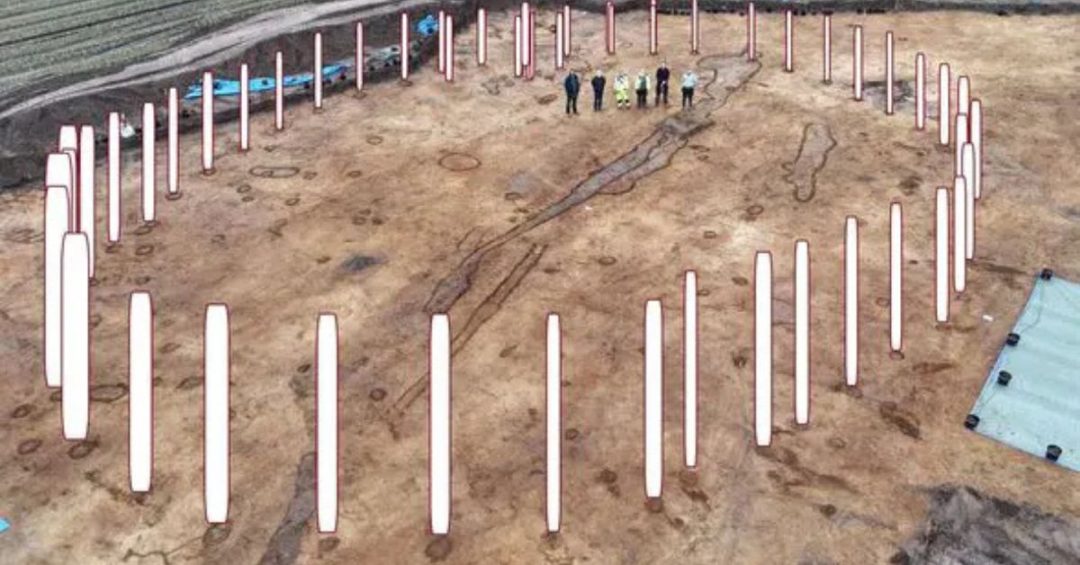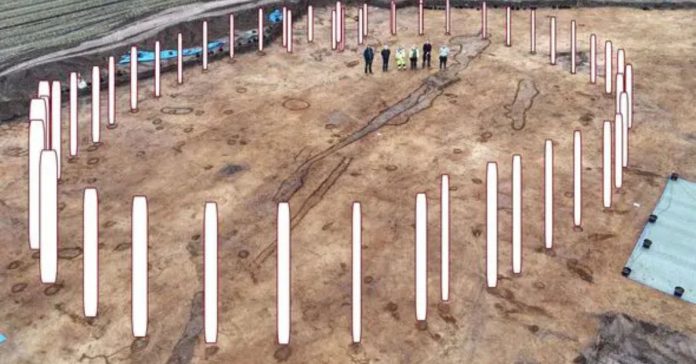Archaeologists in Denmark unearthed a structure possibly linked to England’s Stonehenge. The team discovered it near Aars, North Jutland. Led by archaeologist Sidsel Wåhlin, they called it a once-in-a-lifetime find. The site consists of 45 wooden posts meticulously arranged in an oval formation, stretching approximately 30 meters in diameter. Experts date the structure to between 2600 and 1600 BC. It aligns with Europe’s Neolithic period of major development.

What Was Found?
Experts classify the unearthed structure as a henge—a circular enclosure built from stone or wooden posts. Though most henges are linked to Britain and Ireland, this find suggests similar monuments existed elsewhere. Overlayed images from the Vesthimmerlands Museum reveal Denmark’s henge and its role in prehistoric large-scale architecture. Sidsel Wåhlin, curator at the museum, emphasized its significance, stating, “This is truly an extraordinary discovery.”
The Purpose of Henges
Wåhlin and her team propose that this henge, much like its British counterparts, functioned as a ritual center. During the Neolithic period, communities likely gathered at such sites to perform ceremonies linked to sun worship and agricultural cycles—key elements of life in an era heavily dependent on farming. “To create such a specific monument, people had to deeply understand its meaning and how to design it,” Wåhlin explained. The careful arrangement of the 45 posts and the sheer scale of the oval suggest that its builders possessed both technical skill and a clear vision of its symbolic importance.
Cultural Connections Across Neolithic Europe
This find does more than expand the geographical range of henges; it illuminates the shared cultural landscape of prehistoric Europe. The Neolithic period, from 4000 to 2000 BC, saw agriculture spread and complex societies emerge across Europe. Denmark’s henge, dated to Stonehenge’s era, suggests shared practices and beliefs across distant regions. Farming, sun worship, and spiritual traditions likely unified these ancient communities.
Wåhlin emphasized the structure’s sophistication, noting its scale reflects advanced planning and purposeful design. She speculated that a British visitor might have instantly recognized the henge’s function. This suggests cultural exchange or parallel development across the North Sea.
Why This Matters
The discovery near Aars challenges previous assumptions about the distribution of henge monuments and enriches our understanding of Neolithic life. It points to a time when communities, though separated by hundreds of miles, may have shared worldviews that influenced how they shaped their landscapes. The effort required to erect 45 wooden posts in a precise oval formation reflects not just practical knowledge but also a collective commitment to rituals that likely held deep social and spiritual significance.
In a broader context, this finding underscores the interconnectedness of ancient European societies. As people transitioned from hunter-gatherer lifestyles to settled farming communities, they developed monumental architecture to express their beliefs and mark their presence. The Danish henge, much like Stonehenge, stands as a testament to this pivotal moment in human history—one where the seeds of modern civilization were being sown.
Conclusion
The unearthing of this wooden henge in Denmark is a window into a distant past, revealing a story of ingenuity, ritual, and cultural ties that spanned continents. Thanks to the work of Sidsel Wåhlin and her team, we now have a fuller picture of how Neolithic peoples lived, worshipped, and connected with one another. This “once-in-a-lifetime find” not only bridges the gap between Denmark and Britain but also reminds us of the enduring human impulse to create meaning through the structures we leave behind.

